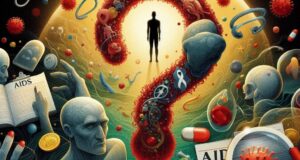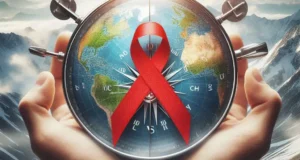Every era has a moment when the wind shifts — silently at first, almost unnoticeably — until the world realizes it has changed forever. For modern medicine, that moment came in 1981, when the United States officially recognized an outbreak that would become one of the most defining and devastating pandemics of our time: AIDS.

At first, it didn’t look like a storm. It looked like whispers in the corridors of hospitals — young, previously healthy men showing up with rare infections and cancers like Pneumocystis pneumonia and Kaposi’s sarcoma. Doctors blinked in confusion. Researchers tilted their heads. And the question slowly took shape: AIDS — where did it come from?
In June 1981, the Centers for Disease Control (CDC) published a short article in its Morbidity and Mortality Weekly Report (MMWR).That one article, quiet and clinical, would later be called the spark that lit the fire of AIDS awareness in America.
But back then, there was no name for it. No identity. No virus. Just fear. The cases multiplied — from California to New York — like smoke rising before anyone noticed a fire had started. It wasn’t long before the mysterious illness gained a name: GRID — Gay-Related Immune Deficiency. But as infections appeared in heterosexuals, hemophiliacs, and infants, it became clear: this was no “gay disease.” It was something deeper, broader, and much more dangerous.
The nation asked in confusion and panic, “AIDS — where did it come from?” The early answers were laced with bias, fear, and misinformation. Many looked for someone to blame rather than something to understand. But behind the hysteria, science was moving — slowly, deliberately, and with purpose.
By 1983, French scientists had identified the virus — later named HIV (Human Immunodeficiency Virus) — as the cause of AIDS. It was a discovery that would reshape the world’s understanding of virology, immunity, and public health. But in 1981, that truth was still hidden beneath layers of doubt and delay.
Metaphorically, 1981 was the first faint rumble of thunder before the downpour. Political silence and media hesitation meant precious time was lost. People continued to ask “AIDS — where did it come from?”,
The early years of the epidemic were marked by tragedy — not only in lives lost but in opportunities missed. The disease became a social mirror, reflecting prejudices around sexuality, race, and class. Those most affected were often those least heard. Yet even in this silence, communities began to organize. Activists, health workers, and loved ones became warriors in a war that governments were slow to fight.
1981 wasn’t just a year on the calendar — it was a line in history. Everything after that would be measured against it. Before 1981, there was no AIDS. After it, the world would never be the same.
has been answered through decades of research. The virus is believed to have crossed from primates to humans in Central Africa — likely in the early 20th century — and silently spread until global travel and medical systems carried it far and wide. But that answer took years. In 1981, all the world had was a puzzle with no picture on the box.

Today, when we look back at that year, we must remember it not just as the beginning of a disease, but as a wake-up call.
And in 1981, we finally saw the enemy — even if we didn’t yet know its name.




